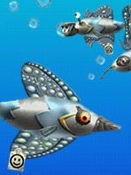The comedian
Rick Overton has said that art was invented when the first man realized that if he banged a stick on the ground, women would dance. With that inspiration, it's understandable that early music making evolved to include handy everyday objects, including natural materials still used today like rocks, animal bones, and hunks of wood. The creation of instruments has gotten much more complex since then, of course, and professional music along with it, but a folk tradition of homemade instruments has continued, as anyone who has ever visited the boardwalk on California's Venice Beach can testify, with instruments ranging from the jug through the spoons to various stringed contraptions. In the 20th century, composers and musicians have readopted the idea that worthy music can be made with found objects. Some of these tools you will never be able to look at again as simply utilitarian:
Bash the Trash: Plays for kids and teaches them how to make musical instruments out of recycled materials.
Car Music Project: Bill Milbrodt, with the help of various musical and mechanical experts, turned a 1982 Honda into a set of unique musical instruments, including a bass made from the gas tank, 55 percussion instruments, flutes made from tubes, a huge drum out of the trunk, and an “air guitar” using the car’s air filter.
Scrap Arts Music: A Vancouver-based group that makes music with instruments fashioned from scrap metal.
Blue Man Group: A performance art group whose creation of instruments out of PVC pipes and boat antennae carried them to Broadway, Vegas and across the world.
Stomp: Another Broadway and Vegas favorite, the members of the troop perform intricate coordinated rhythms using objects from garbage cans and lids to matchboxes.
How to build a rubber balloon bass guitar: About which, seeing is believing.
And don't forget Playing with Your Food, an earlier posting on Library of Links about the Vienna Vegetable Orchestra, an Austrian musical aggregation that plays on instruments made from, well, veggies.
Labels: classical music, performance, Video
 brings to life "...a decade of unparalleled contradiction and complexity...marked by the depths of the Depression on one end...and the height of the modern age at the other...a dance between regional movements and culture...and the alphabet soup of big government projects...." -- from the website. <http://xroads.virginia.edu/~1930s/front.html>
brings to life "...a decade of unparalleled contradiction and complexity...marked by the depths of the Depression on one end...and the height of the modern age at the other...a dance between regional movements and culture...and the alphabet soup of big government projects...." -- from the website. <http://xroads.virginia.edu/~1930s/front.html>
 into the virtual aquariums of the
into the virtual aquariums of the 



